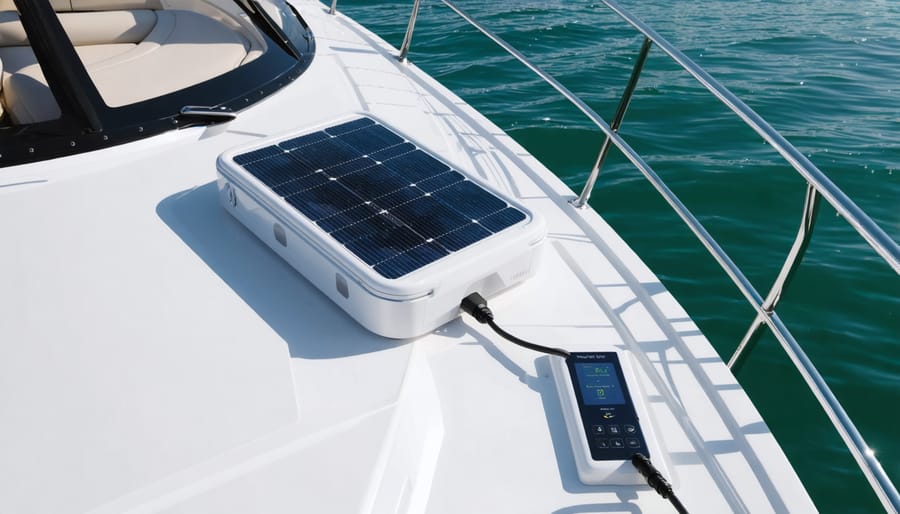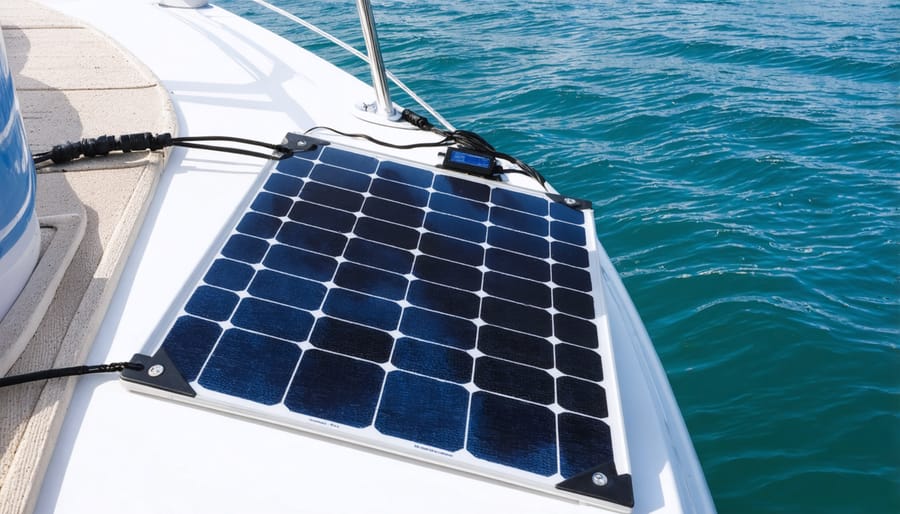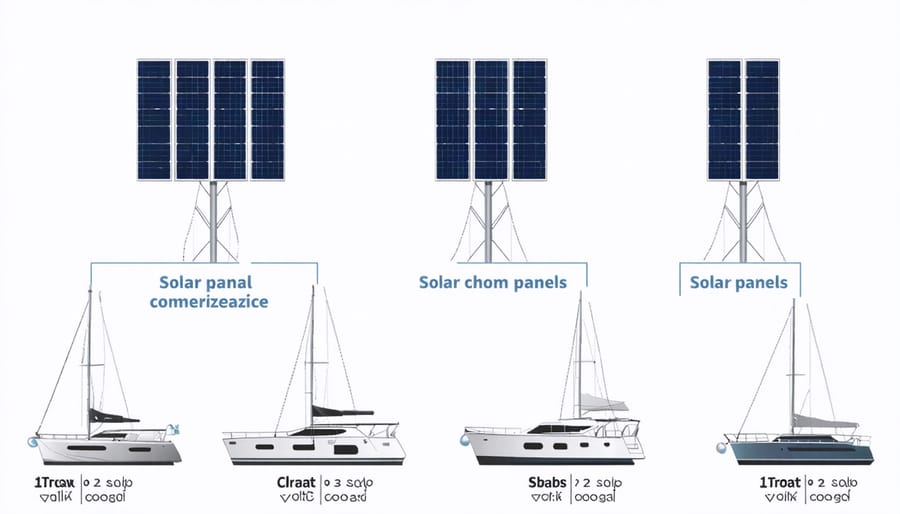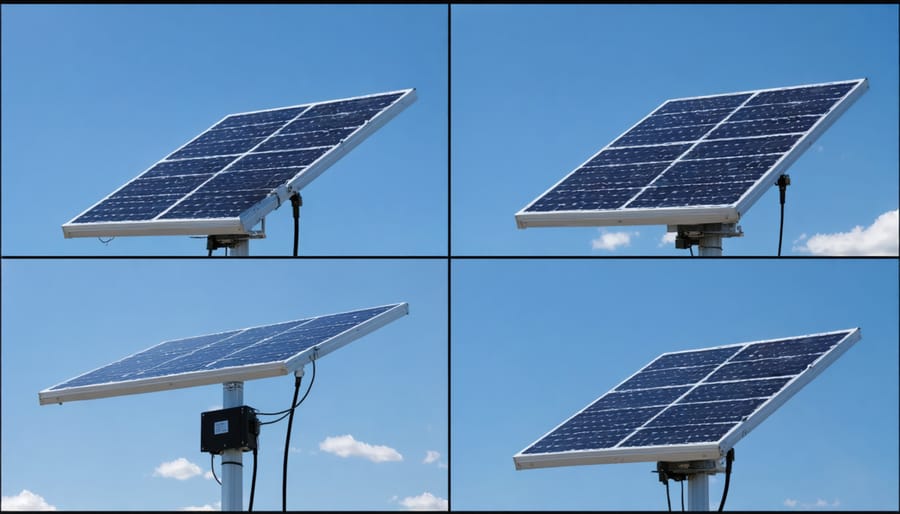Marine Solar Trickle Chargers: Keep Your Boat’s Batteries Alive Even at Dock

Harness the sun’s reliable power to protect and maintain your marine vessel’s batteries with a solar trickle charger – an essential investment for any boat owner serious about battery longevity and sustainable energy solutions. These compact yet powerful devices deliver a steady, low-amperage charge that prevents battery sulfation during extended periods of inactivity, while providing crucial backup power for essential onboard systems. Modern marine solar trickle chargers combine advanced photovoltaic technology with robust, waterproof construction, offering peace of mind whether your vessel is docked at the marina or stored for the winter season. By maintaining optimal battery charge levels year-round, these systems not only extend battery life but also reduce maintenance costs and environmental impact. For European vessel owners navigating diverse weather conditions, these reliable charging solutions represent a smart integration of sustainable technology with practical maritime needs.
How Marine Solar Trickle Chargers Transform Boat Maintenance
The Science Behind Marine Solar Trickle Charging
Marine solar trickle chargers operate through a sophisticated yet straightforward process that leverages advanced marine solar technology. These devices use photovoltaic cells to convert sunlight into electrical energy, maintaining a steady, low-amperage charge that prevents battery degradation during periods of inactivity.
The process begins when photons from sunlight strike the solar panel’s silicon cells, creating an electric field. This generated current passes through a charge controller, which regulates the voltage to prevent overcharging. In marine environments, these systems are engineered to withstand unique challenges, including salt spray, humidity, and variable weather conditions.
What sets marine trickle chargers apart is their intelligent charging algorithm. They typically deliver between 50 and 200 milliamps of current, precisely matching the battery’s natural self-discharge rate. This balanced approach ensures optimal battery health while preventing the formation of damaging sulfate crystals on battery plates.
The charging efficiency varies with factors like panel positioning, cloud cover, and seasonal changes, but modern systems incorporate Maximum Power Point Tracking (MPPT) technology to optimize energy harvest even in less-than-ideal conditions.

Key Benefits for Boat Owners
Installing a marine solar trickle charger offers boat owners several compelling advantages that enhance both vessel maintenance and operating costs. The primary benefit is the significant extension of battery life through consistent, gentle charging that prevents deep discharge cycles. This steady maintenance of optimal charge levels can double or even triple your battery’s lifespan, resulting in substantial long-term savings.
The self-sustaining nature of solar trickle chargers dramatically reduces maintenance requirements. Once properly installed, these systems work autonomously, eliminating the need for regular manual charging or shore power connections. This hands-off approach is particularly valuable for vessels stored in remote locations or used infrequently during off-season periods.
The cost benefits are equally impressive. By harnessing free solar energy, boat owners can significantly reduce electricity costs associated with traditional charging methods. Moreover, the prevention of battery damage and replacement needs generates considerable savings over time. The system’s durability and minimal maintenance requirements further enhance its cost-effectiveness, with quality marine solar trickle chargers typically providing reliable service for many years with minimal intervention.
These advantages combine to offer peace of mind and improved vessel reliability, ensuring your boat’s electrical systems remain ready for use whenever needed.
Choosing the Right Marine Solar Trickle Charger
Essential Features for Marine Applications
When selecting a marine solar trickle charger for your vessel, certain features are essential to ensure reliable performance in challenging maritime conditions. Like other offshore solar solutions, these devices must withstand harsh environments while maintaining optimal charging efficiency.
Waterproof construction is paramount, with an IP67 rating or higher recommended to protect against saltwater spray and complete submersion. Look for corrosion-resistant materials, particularly marine-grade stainless steel mounting hardware and sealed junction boxes, to ensure longevity in salt-air environments.
Charge controllers with built-in reverse current protection prevent battery drainage during low-light conditions, while multi-stage charging capabilities help maintain battery health. Temperature compensation features are crucial for adapting charging parameters to varying weather conditions.
The charger should include robust UV protection to prevent degradation from constant sun exposure. Flexible or semi-flexible panels often work best on boats, conforming to curved surfaces while maintaining durability. Clear LED indicators for charging status and battery health monitoring provide essential feedback for maintenance.
Consider units with multiple mounting options and marine-grade cables with waterproof connectors. The ideal charger should also feature overcharge protection, short-circuit safety, and compatibility with various battery types commonly used in marine applications.
Size and Power Requirements
Selecting the appropriate size and power output for your marine solar trickle charger is crucial for effective battery maintenance. For small recreational boats under 6 metres, a 5-10 watt panel typically suffices to maintain a single 12V battery. Medium-sized vessels between 6-12 metres generally require 10-20 watts to compensate for basic electronic systems and multiple batteries.
For larger boats or those with more sophisticated equipment, consider panels in the 20-50 watt range. Calculate your daily power consumption by listing all onboard devices and their usage hours. Add a 20% buffer to account for efficiency losses and weather variations.
The charging capacity should match your battery bank size. As a rule of thumb, provide at least 1 watt of solar power for every 50 amp-hours of battery capacity. Consider your typical anchoring patterns and local weather conditions – northern European waters may require higher wattage panels to compensate for fewer sunlight hours.
Installation location affects efficiency significantly. Panels mounted flat on deck typically operate at 80-85% efficiency compared to angled installations. For permanent installations, adjustable mounting brackets can optimise solar absorption throughout the season.
Modern marine solar trickle chargers come with built-in charge controllers, but verify the voltage compatibility with your battery system. Most marine batteries require 13.6-14.4V for optimal charging, so ensure your chosen charger can deliver within this range.

Installation and Maintenance Best Practices
Optimal Placement for Maximum Efficiency
The effectiveness of your marine solar trickle charger heavily depends on its placement. Position your solar panels where they receive maximum sunlight exposure throughout the day, typically on flat, unobstructed surfaces like cabin tops or deck areas. Avoid locations where shadows from masts, antennas, or other equipment might interfere with solar collection.
For optimal performance, mount panels at a 30-45 degree angle when possible, allowing natural cleaning from rainwater while maximizing sun exposure. In northern European waters, consider adjustable mounting brackets to compensate for seasonal sun angle variations.
Cable routing requires careful consideration to maintain both efficiency and vessel aesthetics. Use marine-grade cables and ensure all connections are properly sealed against moisture and salt spray. Route cables through existing conduits when possible, keeping runs as short as practical to minimize power loss. Install weatherproof junction boxes at connection points and use appropriate strain relief to prevent cable damage from vessel movement.
Remember to leave sufficient slack in cables to accommodate boat movement and future maintenance needs. Regular inspection of mounting hardware and cable connections will ensure long-term reliability and optimal charging performance.

Maintenance and Troubleshooting
Regular maintenance of your marine solar trickle charger ensures optimal performance and longevity. Clean the solar panel surface monthly using fresh water and a soft cloth to remove salt spray, bird droppings, and other debris that can reduce efficiency. Inspect the panel for physical damage, particularly after storms or rough weather conditions.
Check all cable connections quarterly for corrosion, especially in marine environments where salt air can accelerate deterioration. Apply dielectric grease to terminals and connections to prevent oxidation. Verify that mounting brackets remain secure and haven’t loosened due to vessel vibration.
Common troubleshooting steps include:
– If charging stops, first check for panel shading or debris
– Verify proper connection polarity if the system isn’t charging
– Test voltage output using a multimeter to confirm panel functionality
– Inspect fuses and replace if necessary
– Monitor battery voltage to ensure proper charging levels
For persistent issues, check the charge controller’s LED indicators for error codes. Most modern controllers display specific patterns to identify problems. If voltage output is significantly lower than rated specifications, the panel might require professional assessment or replacement.
Remember to document all maintenance activities and keep the user manual accessible for reference. This helps track system performance and simplifies future troubleshooting needs.
Future-Proofing Your Marine Solar System
As marine technology continues to evolve, ensuring your solar trickle charging system remains adaptable is crucial for long-term effectiveness. Modern marine power systems are increasingly incorporating smart monitoring capabilities and modular designs, allowing for seamless upgrades as your energy needs grow.
Consider investing in controllers with Bluetooth connectivity and remote monitoring features, enabling real-time performance tracking and maintenance alerts. These smart systems can help optimize charging efficiency and extend battery life through precise power management.
Scalability is another key consideration. Starting with a basic trickle charger doesn’t mean you’re limited to that capacity forever. Look for systems that allow additional panel integration and battery expansion. Many modern charge controllers support multiple charging technologies, making it easier to integrate new battery types as they become available.
Future-proofing also means considering environmental regulations. European maritime standards are becoming increasingly stringent regarding sustainable energy solutions. Choosing equipment that already meets or exceeds these requirements helps ensure long-term compliance.
For maximum adaptability, select components with standardized connections and industry-accepted protocols. This approach facilitates easier upgrades and replacements, protecting your investment while keeping pace with technological advancements in marine solar technology.
Marine solar trickle chargers represent a significant step forward in sustainable vessel maintenance, offering reliable battery care while embracing eco-friendly practices. These innovative devices not only extend battery life and reduce maintenance costs but also contribute to the broader goal of maritime sustainability. By harnessing solar power for battery maintenance, boat owners can ensure their vessels remain ready for use while minimising their environmental impact. The investment in a quality marine solar trickle charger pays dividends through enhanced battery performance, reduced electricity consumption, and increased peace of mind. As we move towards a more sustainable future in marine operations, solar trickle chargers stand out as an essential solution for responsible vessel ownership. Consider making the switch to solar power for your marine battery maintenance needs – it’s a choice that benefits both your vessel and our planet’s future.
Leave a Reply